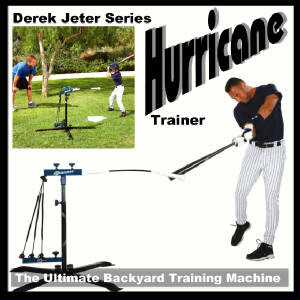 www.DerekJeterHurricaneMachine.com
www.DerekJeterHurricaneMachine.comIt has been stated many times that pitching and defense wins ball games. We all know that it would be real boring if that is all teams did. It has been proven time and time again you can win without hitting.
By John R Di Nicola
However we do have to address the issue so we have to practice hitting. Listed below are 5 stations that will help get your hitters ready for the live action of a game. You will need assistant to carry out these drills. It is important you recruit help. How much help you get will determine how many of these stations you will be able have in a practice.
Hitting off 'T"
Soft Toss
Tracking
Bunting
Batting Practice
Hitting off the "T"
You will for sure have to have hitting of a "T". This is mandatory. You will be limited to the amount of pitches you will throw each hitter. The more swings that get hitting off the "T" the better they will be prepared for batting practices and the game. The first few times through this stations have them hit the as if it were down the middle. Make sure the "T" is no higher than the players waist. Working on the following:
important that the feet are shoulder width apart and player is balanced
when hitting the ball the top hand always on top of the ball
hit the top of the ball driving it downward
pivoting back foot raising heel as the hands follow through hitting zone
As they get comfortable you can position the "T" for the inside pitch and out side pitch. Important when working on outside pitch to position the "T" behind home plate so as to illustrate to players they have to wait on the out side pitch. Also teach them to bring their hands back so their front shoulder turns in toward home plate. This will bring front foot in so they can drive the ball. Most players will open up the front shoulder and hit the ball off the end of the bat or completely miss it.
Soft Toss
The soft station is an extra in Little League. You may want to wait till later on in the season to use this station. Basically a coach on one knee positioned beside player and tossing ball to different zones of the plate. Players swings through ball using all the proper techniques from "T" drills. Hands on top of ball driving through the ball.
Tracking
This an an excellent drill to teach the Little League Player on keeping their eye's focused on the ball. Your above average hitters always work on tracking. Most of them will take pitches just to get the feel of how the pitcher is throwing. They always make the pitchers throw a lot of pitches. Teach them to follow the ball all way to the catcher mitt. This something they should do during batting practice and the game. The more they see the ball the bigger it looks. You can use a rag ball or a whiffle ball.
Bunting
The art of Bunting is so important at all levels of baseball and most neglected. In this day and age of baseball the Home Run is king. It has been proven in recent world series that small ball will win more championships than the Home Runs. Have them bunt at least five balls, down first base line and third base line. Later on you can work on bunts for base hits.
Batting Practice
Because you have so much do and trying to get all the players to hit you have to limit the amount of pitches to each batter (15-20). Have players first work on making contact. You will have the seasoned Little Leaguer who knocks the cover off the ball and then you will have the ones that you really have to work with to get them to make contact. This is why if you have the luxury of having the help to run the stations it would greatly speed up the learning curve.
Most likely you will only use the "T" and Live Batting Practices. Using this model will afford you to run a practice without having a marathon practices. Do not try and do all 5 stations the first practice. As you become comfortable you can adjust your practice schedule and add stations. Most likely you will never do all five in one practice.
Practices Makes Perfect
Thank you for taking the time to read my article. If you would like further information on this topic or other information you can E-Mail me at: jdinicola@easypitching.com
You can follow us on Twitter http://twitter.com/easypitching
Web site: http://www.easypitching.com
Article Source: http://EzineArticles.com/?expert=John_R_Di_Nicola
CoachesBest.com
HurricaneTrainer.com
BatAction.com
HandsBackHitter.com
QuickSwingTrainer.com
AdvancedSkillsTee.com
BattingCagesDirect.com
BattingCagesrUs.com








